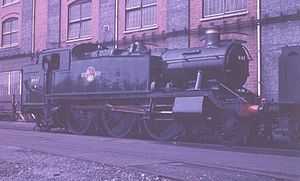GWR 6100 Class
| GWR 6100 Class | |
|---|---|
|
6147 at Swindon Works on 26 April 1964 after overhaul | |
| Type and origin | |
| Power type | Steam |
| Designer | Charles Collett |
| Builder | GWR Swindon Works |
| Order number | Lots 269, 278, 291 |
| Build date | 1931–1933, 1935 |
| Total produced | 70 |
| Specifications | |
| Configuration | 2-6-2T |
| UIC classification | 1'C1 ht |
| Gauge | 4 ft 8 1⁄2 in (1,435 mm) |
| Leading wheel diameter | 3 ft 2 in (0.965 m) |
| Driver diameter | 5 ft 8 in (1.727 m) |
| Trailing wheel diameter | 3 ft 8 in (1.118 m) |
| Minimum curve |
6 chains (400 ft; 120 m) normal, 5 chains (330 ft; 100 m) slow |
| Length | 41 ft 0 in (12.50 m) over buffers |
| Width | 8 ft 11 1⁄4 in (2.72 m) |
| Height | 12 ft 7 5⁄8 in (3.85 m) |
| Axle load | 17 long tons 12 cwt (39,400 lb or 17.9 t) full |
| Weight on drivers | 52 long tons 13 cwt (117,900 lb or 53.5 t) full |
| Locomotive weight | 78 long tons 9 cwt (175,700 lb or 79.7 t) full |
| Fuel type | Coal |
| Water capacity | 2,000 imp gal (9,100 l; 2,400 US gal) |
| Boiler pressure | 225 lbf/in2 (1.55 MPa) |
| Firegrate area | 20.35 sq ft (1.891 m2) |
| Heating surface: – Tubes | 1,145.00 sq ft (106.374 m2) |
| – Firebox | 121.80 sq ft (11.316 m2) |
| Superheater type | 4-element or 6-element |
| Superheater area |
4-element: 58.56 sq ft (5.440 m2), 6-element: 77.68 sq ft (7.217 m2) |
| Cylinders | Two, outside |
| Cylinder size | 18 in × 30 in (457 mm × 762 mm) |
| Valve gear | Stephenson |
| Valve type | Piston valves |
| Performance figures | |
| Tractive effort | 27,340 lbf (121.61 kN) |
| Career | |
| Operator(s) | GWR » BR |
| Class | 6100 |
| Power class |
GWR: D BR:4MT |
| Number(s) | 6100–6169 |
| Axle load class | GWR: Blue |
| Withdrawn | 1958–1965 |
| Disposition | One preserved, remainder scrapped |
The GWR 6100 Class is a class of 2-6-2T side tank steam locomotives.
History

The class was designed by Charles Collett and introduced in 1931, and were a straightforward development of the earlier 5101 class (and for that matter the 1905 3100/5100 class). The main difference from their predecessors was an increased boiler pressure of 225 psi (1.55 MPa) with a consequent increase in tractive effort.[1]
There were seventy in the class, built in two batches in 1931–1933 and 1935. They were frequently referred to by trainspotters as 'Tanner One-ers'- being a reference to their '61xx' numbering sequence using colloquial terms for a sixpence and a penny.
The class was specifically built for commuter services in the London area where they replaced the ageing 2221 class on these services. They lasted to the end of steam on the Western Region of British Railways in 1965, never straying far from their home turf. Typical duties were Paddington to Aylesbury via High Wycombe, and from the same terminus to Oxford, Windsor, Reading and Basingstoke. They were mainly shedded at Old Oak Common, Southall, Slough, Reading and Aylesbury throughout their lives. In the early 1960s, the advent of the first generation diesel multiple units made them semi-redundant though generally far from worn out. Their last few years saw them on more menial duties, as in the adjacent photograph, until scrapping.[1]
Preservation

One locomotive, 6106, has survived into preservation, and is at Didcot Railway Centre, though currently non-operational.[2]
Models
The erstwhile Kitmaster company produced an unpowered polystyrene injection moulded model kit for 00 gauge. In late 1962, the Kitmaster brand was sold by its parent company (Rosebud Dolls) to Airfix, who transferred the moulding tools to their own factory; they re-introduced some of the former Kitmaster range, including this model. The tools were subsequently sold again to Dapol who have also produced this model.[3]
Triang also produced a powered model of 6157 in TT scale[4]
See also
References
- ↑ 1.0 1.1 le Fleming, H.M. (February 1962). White, D.E., ed. The Locomotives of the Great Western Railway, part nine: Standard Two-Cylinder Classes. RCTS. p. J33-J34.
- ↑ 6106 at Didcot Railway Centre (Accessed 2008-11-02)
- ↑ Knight, Stephen (1999). Let's Stick Together: An Appreciation of Kitmaster and Airfix Railway Kits. Clopthill: Irwell Press. ISBN 1-871608-90-2.
- ↑ see the Triang Catalogue at http://www.tri-ang.co.uk/TT/prarie.htm
- Whitehurst, Brian (1973). Great Western engines, names, numbers, types, classes: 1940 to preservation. Oxford: Oxford Publishing Company. pp. 56, 102, 136. ISBN 0-902888-21-8. OCLC 815661.
External links
| Wikimedia Commons has media related to GWR 6100 Class. |
| ||||||||||||||||||||||||||||||||||||||||||||||||||||||||||||||||||||||||||||||||||||||||||||||
